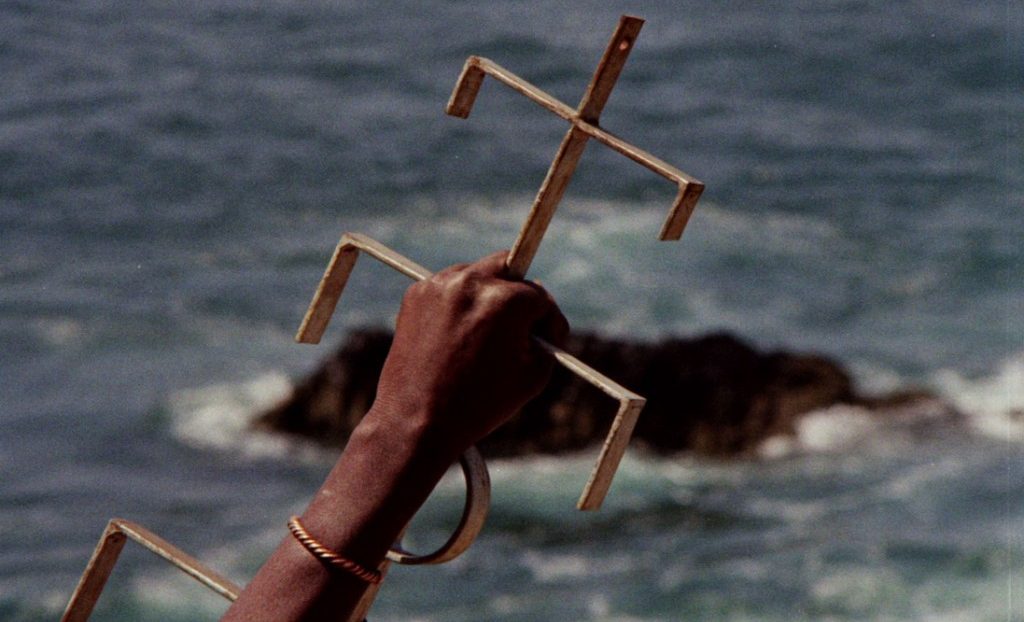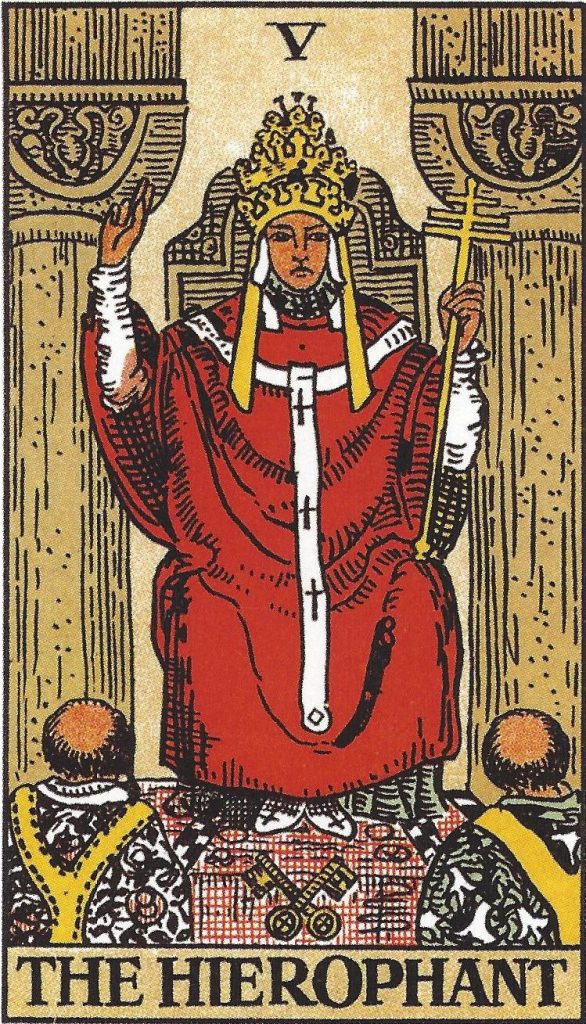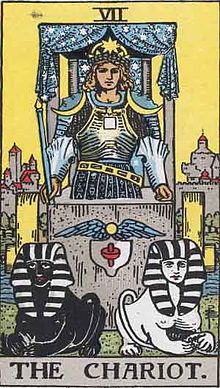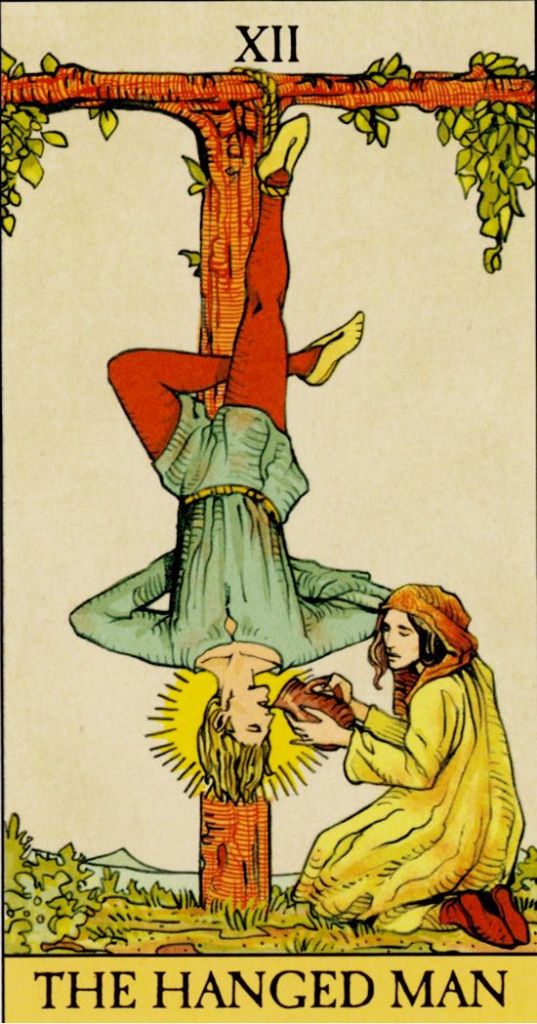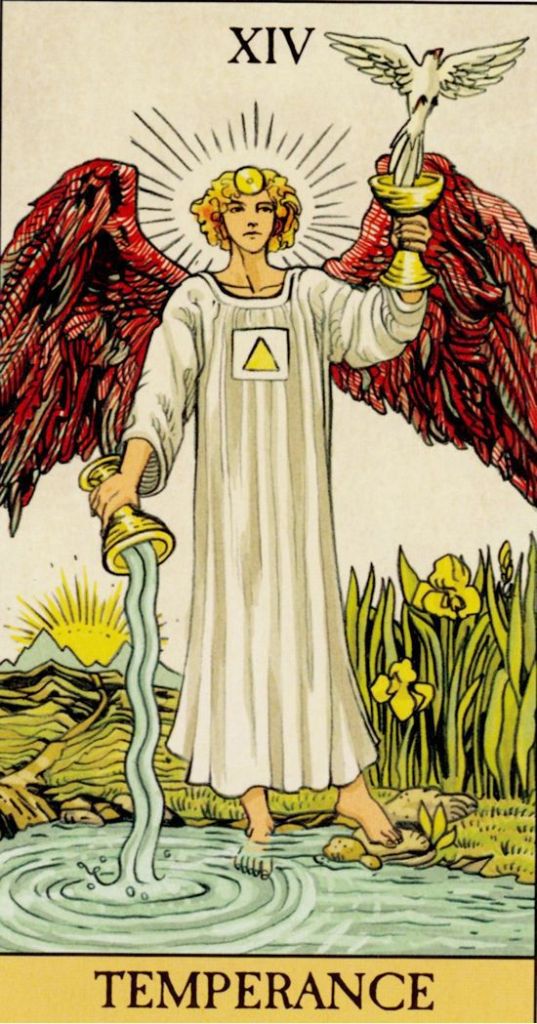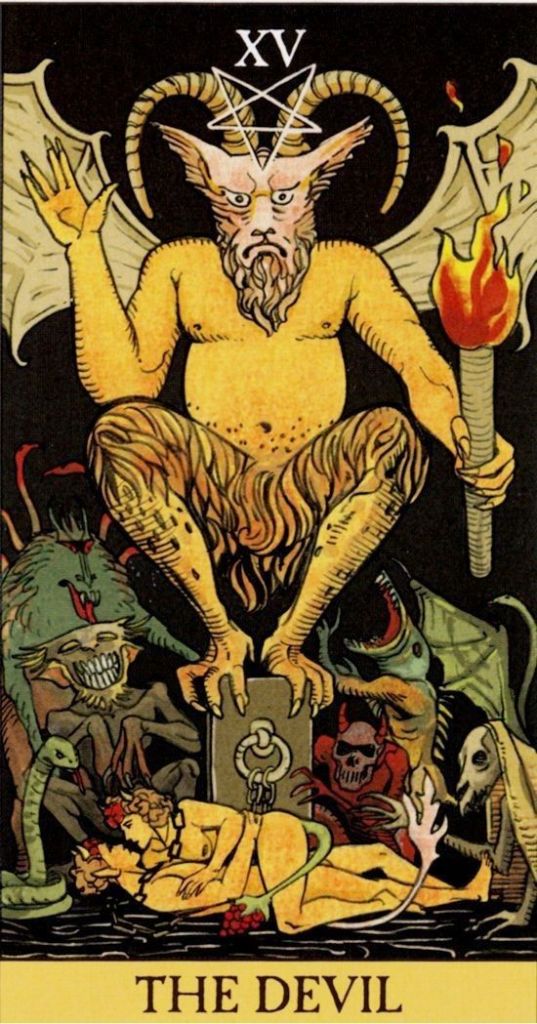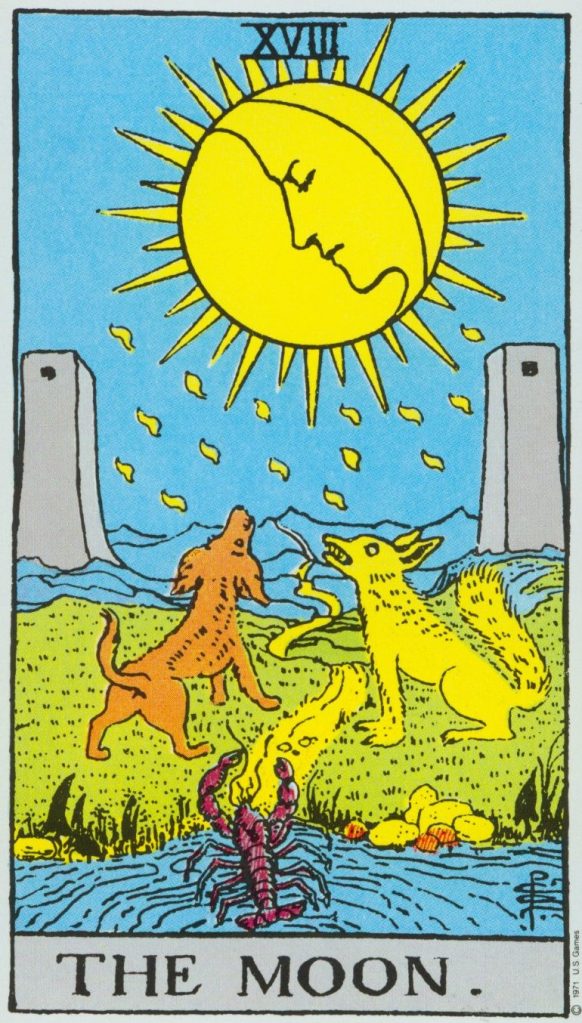You might be familiar with the unique imagery of the Rider Waite deck, but many of us who practice tarot or are just beginning aren’t familiar with the After Tarot. The cards are recognized by the soft illustrations of Guilia F. Massaglia and creative concepts by Pietro Alligo. The After Tarot looks to the future. Taking the traditional imagery from the original deck and transforming the reader’s thought pattern from the now to the next.
The Rider Waite
This deck is great for those just learning tarot. It is the story of the hero’s journey. If you keep this concept in the back of your mind, with each reading the story will seem to tell itself. This deck is straight forward yet one of a kind. It is the source of inspiration for every other deck out there. The cards are simple, yet every time I return to them I’m able to discover something new. The images transcend language because they are highly intuitive. They can be universally interpreted by anybody reading them not only by what’s on the card but the feelings they give you.
The After Tarot
Although it attempts to further explain the Rider Waite, it doesn’t completely cloud the reader’s judgement. The cards in this deck leave enough room for the reader to fill in the blanks while providing a bit more clarity and keeping a forward-focused approach. It brings new perspective to the table while still using the traditional, universal language of the Rider Waite. In fact, using both decks together has changed my personal ability to read for the better. The level of insight that comes with these two decks in tandem is highly amplified. Sometimes there might be cross over between the two or you might notice details in one deck that reflect the other, seemingly feeding off of each other. Where one ends, the other begins.
0 The Fool
The beginning of the hero’s journey starts here at high noon. This is a solo journey, although the fool is not totally alone as he is followed by an innocent white dog, nipping at his feet. In the Rider Waite, he is unaware of what awaits him on the other side of that cliff. The fool signifies taking ownership of one’s own life. In the After Tarot, the Fool finds that the other side of the cliff lies more uncertainty as he dangles off of it, single-handedly. He’s a risk taker, but even in the face of danger he is content because of his blind trust in the world and in humanity. The After Tarot version of the fool represents a deep sense of letting go of control, weightlessness, an acceptance of fate. His belongings are dropped off the side of the cliff, abandoning the weight of responsibility, and he lives lighter because of it.
I The Magician
The Magician reminds us that the world is our oyster; our assets completely laid out on the table in front of us. The double-edged candlestick represents the good and the bad in all of us and how we might use those assets to our advantage; pure manifestation vs outright manipulation. In the After Tarot, the magician now uses all the tools in his arsenal as they float around him in midair. He refuses to give up his power. The tools on the table are now replaced with a white dove, begging the question: will you use your power to help the world or will you use it for your own personal gain? Everyone has the capacity for both.
II The High Priestess
The High Priestess maintains her allure no matter what. And she does it elegantly, too. In the original deck, the crescent moon at her feet engulfs her, safeguarding her true feelings. Her secrets and emotions dictate what she does and how she acts, instead of her being in control of them. In the After Tarot, the moon faces away from her, suggesting she has more confidence in keeping her thoughts, even when she feels exposed. She holds the key and isn’t worried about the possibility of anything getting out behind that Mona Lisa smile. She represents the acquisition of universal, non-verbal knowledge. Innate knowledge that cannot be learned but can only be understood through one’s own intuition.
III The Empress
All rivers lead to the same source of life; at the Empress’s feet. She represents the safety of the womb, the security of the mother, and the beauty that is her ability to create all that is living. Not only is she happier when she is depended on, but she needs to feel needed. She is an essential part of the circle of life. The symbolic glyph of femininity is translated into the After Tarot. A family of geese gathers at her feet as she protects their innocence in the most graceful, beautiful way possible. She understands that you cannot be victorious in love because it is not about a clear winner or loser, that everyone should win in love.
IV The Emperor
In the Rider Waite, the emperor’s steel-toed feet instill fear in his enemies. He uses intimidation as a form of power, hindering him from experiencing real affection. Unlike the empress, he wants victory instead of peace. He represents war dictating a clear winner and a clear loser. In the After Tarot he is able to tame even the wildest creatures with his dominance as a wild ram lays calmly at his feet. Sat upon his concrete throne, the emperor is an instantly recognized pillar of authority. And with authority comes the promise of safety from our enemies.
V The Hierophant
Every ecosystem needs structures in place to keep it alive. The Hierophant represents the figurehead of these systems. He doesn’t practice authority in the way of the emperor, rather, he is more fair and discerning. The Rider Waite hierophant represents traditional spiritual leadership, counsel, the church, viewing all in the community as equals. He recognizes that the powerful need the people as much as the people need the direction that power brings. In the After Tarot, he believes in transparency as the basis of trust between himself and the people he governs as he holds his book open for all to see.
VI The Lovers
The original lovers card is filled with innuendo. The snake coiled around the tree in the scene of the first man and woman suggests temptation; but what they do not know is that they both possess free will. They have not yet made a decision to succumb to temptation, but once they do they must realize that every action comes with a consequence. In the After Tarot, the decision has been made, the apple has been bitten, fate has been sealed, solidified by the sword of the gods. The snake slithers away but their actions remain forever and they must accept the consequences that come with them, good, bad or indifferent. The Lovers is a scene that depicts when fate meets free will; the constant decision-making processes of life and their ultimate influence on the paths we will walk down.
VII The Chariot
The Chariot is the vehicle that transports you from beginning to end on your life’s journey. It appears to give you a sense of direction. It is a new branch on the tree of life that has many different paths and many different branches. The Rider Waite chariot is the vehicle before it hits the road whereas the After Tarot depicts the chariot in motion. When the Chariot appears, you know you are on your way. It encourages you not to forget the past but not to look back at it either. In reverse, the chariot suggests a fork in the road ahead; a stall in the vehicle.
VIII Strength
Sometimes the only thing to save us in the face of adversity is our own inner strength. Strength isn’t defined by brute force or overbearing behavior but by resilience and sheer will power. It encourages us to take accountability and not to fold during times of hardship. The original strength card depicts an untamed lion, fallen under the hands of an innocent woman in a white robe. Her purity is the only defense against the lion. In the After Tarot, the woman wraps her arms around the lion lovingly. She remains dominant and in control yet gentle, which is the truest measure of real strength.
IX The Hermit
The Hermit might on the surface appear to be the antithesis of strength, but really he is the silent juggernaut. The Rider Waite hermit is led only by the light of his lantern and the guidance of his walking stick. He navigates the landscape on his own, without feedback from anyone else; nothing to dispel his fears in moments of uncertainty and nobody to praise his success. The After Tarot depicts the hermit this time not with a walking stick but with a coiled snake. A black dog is at the hermit’s side, a figure that at a glance might intimidate one in total darkness. In reverse it represents a lack of inner reflection; an inability to look at oneself in the mirror. Too much noise. Too much distraction. When the hermit appears, you have the need to be humbled. To sit in a quiet room with solitude as your only companion and just be. When you strip your senses of all stimulation and are truly alone with yourself, are you at ease? The Hermit begs this question.
X Wheel of Fortune
Out from the darkness comes the brightest of lights. When an opportunity presents itself to you, at times it seems to appear out of thin air. When the wheel shows up, you are at the mercy of the unpredictability of the universe, and sometimes unpredictability can seem scary. However, it may be a blessing in disguise. The After Tarot includes a monkey hanging along the side of the wheel, seemingly spinning the wheels of fate itself. What it lands on, you must trust that it is what you karmically deserve. Karmic debts are being paid either by you or towards you.
XI Justice
A fair judge does not practice equality but equity. He is able to objectively look at the facts and promptly make his decision. He realizes that karmic debts have no boundaries between rich or poor, man or woman, young or old. He is completely neutral. The Rider Waite justice card is much more stern, wielding his sword and threatening to use it against any disillusionment or dishonesty. The After Tarot justice is much more humane, depicting a rich man and a poor man on trial, suggesting that everyone gets the same treatment in front of a neutral judge, no matter their status in society.
XII The Hanged Man
The Hanged Man is the epitome of the lost soul. He is in a constant state of discomfort because while he is living in the subconscious, he exists in his human body and still needs to tend to those human needs. The original Hanged Man has one foot bound to a post, representing his human form here on Earth. The other is suspended in midair. This represents a split in the part of him that must interact with the physical realm and tend to Earthly responsibilities while simultaneously doing spiritual work. In the After Tarot, the Hanged Man’s dependence on others to compensate for his lack of responsibility is highlighted by the woman keeping him alive and giving him water to drink.
XIII Death
Death is one of the most natural occurrences on Earth; a give and take between the living and the universe. It is not the antithesis of life but a part of the life cycle itself. We are surrounded by it all the time and without it there would not be room for anything new. The original Rider Waite death card depicts the living in their last moments, begging for mercy from Death riding in on his white horse. In the distance lies a rendition of the moon card reminding us that the sun rises again after destruction no matter how long it may take. The After Tarot shows the aftermath of this destruction, cleansing the population of people in front of him. A boat with a red sail floats down the river, symbolizing the bloodletting of the old to create space for new life.
XIV Temperance
Temperance is the angel of death; the savior to retrieve your soul after you leave this planet. But it’s much more than that, too. She represents purity, innocence, and patience. Red wings promise renewal after the destruction of death. Pouring water between each chalice represents the delicate balance of life in the hands of our guardian angels. In the After Tarot, she empties the water from one chalice while releasing a white dove from the other. She acknowledges the flaws of humanity and exercises love despite it, baptizing us in the process.
XV The Devil
Make no mistake, the Devil is yet another guardian angel. In an attempt to introduce us to our best selves, he brings temptation into our lives. Although we may not know it, just like Adam and Eve we have the power to free ourselves from these situations if we so choose, as illustrated by the chains around their necks. The Devil has a strong grip on these chains, creating tension. However, they are loose, and they are able to break free of them if they so choose. In the throes of temptation, they fail to see an exit; but there is always a way out. In the After Tarot not only do they feel bound to their deviant nature but they relish in it. They relinquish the responsibility that comes with autonomy and indulge in their drug of choice, whether that be substances, food, sex, or general rebellion. In a way, they find safety in the macabre.
XVI The Tower
Oh how hard the mighty fall from their ivory towers. The more you have, the more you may have to lose. The Tower reminds us that when things suddenly fall through they can feel catastrophic but, just like death, it all happens for a reason. The After Tarot shows how gruesome the result of loss can be when lightning strikes; royalty literally lays on the ground with the rest of the commoners, their belongings, and legacy completely destroyed. Wiping out the untouchables and unforeseen mayhem. The Tower represents change. Sudden change. It may seem unwarranted but under the surface it is justified.
XVII The Star
When we look up to the celestial bodies, we are looking for guidance. For hope and a sense of security in times of uncertainty. The star represents alternative religions and spirituality unique from traditional religious structures. The star card is connected to every part of this planet; to every living and nonliving thing. It recognizes that every action has an equal and opposite reaction. In the After Tarot, the star attempts to lift the veil of reality as the woman engulfs herself into the river, bathing herself in the knowledge of the universe. She realizes that acquiring knowledge is useless if you do not share that knowledge with humanity.
XVIII The Moon
The Earth’s moon illuminates the creatures and secrets that exist in the dark and cannot be exposed by proper daylight but only by the light of night. The absence of the cloaked woman in the Rider Waite deck and her presence in the After Tarot suggests a shift in perspective between the waking hours and the night. The delusions, fallacies, and mirages of our subconscious may appear at night in the form of dreams, forcing us to confront them as we cannot due to the distractions of everyday life.
XIX The Sun
The epitome of truth, light, and happiness. No need or any extra effort or added pressure, the sun represents pure joy and innocence, represented by the white horse. Relief, and revitalization. The children highlighted in the After Tarot are reminiscent of childhood and a happy past. The greatest of memories that we store in our brains to keep us going in times of hardship. Manifestation of our greatest hopes and our greatest fears dispelled. Simple and plain. Anything worthwhile doesn’t need to be over explained.
XX Judgement
The great reckoning day we all fear but at the same time hope for. The resurrection of Jesus; the final hour. At the end of the day we pay our karmic debts. It doesn’t matter how much of a martyr or how much of a savior we think we were in our lifetimes, the end of the story remains the same for all of us. The flag in the original Rider Waite judgment card represents atonement. In the After Tarot, those who believe go to heaven (metaphorically, if you don’t believe in that sort of stuff) and those who do not stay with their bodies here on Earth. It is a form of karmic retribution.
XXI The World
And the cycle continues. We return to the physical realm in the form of reincarnation. Our lease on life renews not as an offshoot on the same tree but as a whole new seed entirely. We return with fresh eyes and a deeper ability to understand how all the cogs fit together in the puzzle of the universe. In the After Tarot, the figures surrounding the card are replaced by the suits (Swords, Cups, Wands, and Pentacles), representing our life’s dreams being realized. The world card is a perspective of Earth from above, an abstract interpretation of life, and the start of a new cycle.
